
2cm Flakvierling 38 Late Production w/crew
Dragon 1:35 Scale Smart Kit No. 6547
Kit review by Terry Ashley
Technical Advice by Jon Bailey

The Gunner fired the weapon by way of two foot pedals; each pedal fired the two diametrically opposite guns allowing the other two guns to be reloaded for sustained firing. It had a maximum combined rate of fire of 1,400 rounds per minute although the practical combat rate was 800 rounds per minute.
It could also be fired in automatic or semi-automatic mode and all four guns could be fired at the same time by depressing both firing pedals in emergencies but not recommended due to ammunition use.
The mount was normally transported on an Sd.Ah.52 trailer towed by vehicles such as 3/5t trucks and Sd.Kfz.11 half tracks as well as mobile AA vehicles such as the Sd.Kfz.7/1 half-track and Panzer IV based Wirbelwind plus some local one off installations.
As well as Wehrmacht use, the Flakvierling 38 was also used by the Kriegsmarine fitted to U-boats and ships as well as on trains, fixed installations such as around harbours and on flak towers and was very well respected by Allied pilots due to the high rate of fire.
The kit gives you the full Flakvierling 38 mounting on the triangular base without the Sd.Ah.52 trailer plus 4 crew figures with the ability to build the kit in firing or travel configuration as well as a few optional parts for the gun sights and shields. The kit consists of 134 parts in light grey plastic and another 30 figure parts for the crew plus 9 etched parts along with a 4 page instruction sheet.

Standard of moulding is very good with few if any pin marks visible after assembly and only the odd bit of fine flash with the normal mould seam lines and the many plastic nodes being the only cleanup needed on the parts. There are some quite small and fine parts that need the usual care in cleanup and assembly but the level of detail definition as result of these parts is very good overall.
Dimensionally the kit matches well with the available 1:35 plans in the books listed below; these are mostly showing the Flakvierling 38 on mobile mounts such as the Wirbelwind and Sd.Kfz.7/1 so not all the features are measurable, such as the triangular base. Those features than can be checked were mostly within acceptable tolerances given there were also some minor differences between the plans themselves which doesn’t make things easy.
The four part recuperator housing with smooth circular port covers on either side with bevelled joins edges resulting in a clean join not requiring any filler. The housing fits to its mounting plate and in turn to the front of the Upper Carriage.
The large locking lever (part A16) can be left off until later in the assembly for ease of handling and there is a choice of two styles of front spent shell collector box, one with the flap moulded down and the other with the flap moulded up. This means you have to make a choice of an open or closed collector box at the point of assembly depending on the final model configuration.
At the back of the carriage is the gunner’s position with lower firing pedals moulded with the foot plate, this makes the pedals a bit chunky and you may wish to trim these at the back for a better appearance? The seat support and traverse gear drive shaft are in one piece with the gunner’s seat and backrest as separate parts, the drive shaft ends fit into the foot plate and underside of the traverse gear housing without any problems.
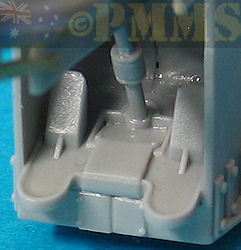
There is a second option for the gunner’s seat with the seat support separate from the gear shaft and inner section of the support with four etched support strips joining the seat support in the same manner as the real seat. This allows you to raise the gunner’s seat if you wish by repositioning the angle of the support strips. You have to ensure to glue the strips perfectly evenly on both sides of the inner support for an even finish, there are small pins on the parts to help with the alignment. The only issue is the etched strips have indent styling at either end, yet most references show the strips are smooth bars, other than that this is a very nice inclusion for added detail, something we are bound to find in aftermarket sets for the other Flakvierling 38 kits available.

The traverse gear housing is in two parts with separate traverse hand wheels but the two small thumb knobs are very basic lacking any real detail. The assembled gear housing attaches to its mounting plate which in turn is attached to the upper carriage while aligning with the top of the traverse gear drive shaft.
The main sight bracket is a one piece moulding with nice clean detail on the sides but on the inside of the outer half is a small plug piece that will need some filler as the fit is not that good. The main sight bracket is attached to the upper carriage recess next to the battery box along with the stop handle (part A1). The smaller L shaped sight bracket arm is attached to the main bracket by way of the small locating pin (part A54) but this pin is not shown in the instructions as is DML want so you have to find it yourself (unless you read this first of course).
This pin allows the sight arm to move along with the gun elevation for proper alignment but again the fit is not that good as the locating hole in the main bracket is a lot bigger than the diameter of the pin and it’s difficult to get a good glue purchase without also gluing the sight arms.
But that’s all academic really because when you come to fit the connecting rod (part A45) between the left gun carriage and sight arm it has to be glued in place negating and movement of the sight or gun elevation unless you modify the rod attachment points to move?
Added to the bracket arm is a choice of gun sights, you get the early Flakvisier 40 sight with distinctive square sight housing or the later Schwebekreisvisier 30/38 sight but given the kit is labelled “Late Production” you should use the Schwebekreisvisier 30/38 sight and consign the Flakvisier 40 to the spares box.
The Schwebekreisvisier 30/38 sight is fairly basic in detail with the small rear sight moulded solid and lacks the gunner’s eye piece while the forward sight ring in plastic has an inner ring in etched brass but lacks the pendulum balance arm. The sight mounting bracket is also fairly basic but does include the ground scope sight to allow the gun to be used as AA or for ground targets.
The small gunner’s shield with separate sight door is added to the top of the carriage.

Overall 2cm FlaK gun

There are additional 20 round magazines to add to the guns if you wish for action mode.
The circular gun cradle detail is nicely defined and includes the curved front gun shield around the front edge although the left shield doesn’t have the small rectangular cut-out at the top as it should and you may want to cut this yourself? The two fine firing levers are at the rear plus the two small deflecting pullies on the rear edge of the left side cradle and a decal for the engraved elevation quadrants around the curved lower cable drum bracket also on the left side.
Added to the cradles are the guns/sleighs along with the recoil cylinders for a fairly quick and easy sub-assembly due to the guns/sleighs and cradle/shields moulded together.
The gun cradles are attached to the Upper Carriage by way of the central bushing (part A48), which has a square hole designed to take the square locating lug on the back of the gun cradles and care is needed to get a good glue purchase without also gluing it to the carriage. But if you don’t intend to make the guns/sight movable due to the issues with the connecting rod then just glue the carriages to the cradle at the desired elevation making sure they align correctly with the opposite gun cradle.
After attaching the Gun Cradles to the Upper Carriage the connecting rod (part A45) is attached to the left side Cradle and sight arm but is designed to just glue in place as mentioned above. Therefore you have to decide on the gun elevation required as you glue the connecting rod in place.
If you wanted to have the guns elevate the pivot points for the sight arm and connecting rod would need to be altered with pins added to allow movement which shouldn’t be a huge task for the average modeller.
You should also note if you intend to build the kit in travel mode not to fit any of the magazines as the main gun shields will not fold flush with the magazines fitted.
Also included are the two tube couplings for the gun shields but the foot rests are missing from in front of the magazine racks as are the brackets for the folded outer slatted board section.
The two Loader’s seats have separate back rests and mounting posts which are glued to the outer walk board section either with the seats in the raised firing or folded travel modes, you have to make a choice along with fitting the outer board sections in the lowered or folded positions.
The central cover plate on the Base has a recess for fitting the corresponding circular lug under the Platform, this is not actually attached so you should take care if not glued in place.
The plastic shield/mounting plates are moulded a uniform thickness (or should that be thinness?) with fine rivet, bracket and latch detail on both sides as well as being completely free of any pin marks for nice looking plastic shields.
The inner support brackets (parts H1, H2) are fitted at an angle of about 70 degrees to the main shields which is not that clear in the instructions and there are actually two sets of shields in the kit, one in deployed mode and other folded for transport mode. This does seem over kill instead of just giving you alternate top sections of the inner shield to position open or closed but I guess it saves a little work in just using which ever shield mode you wish.
The pin on the bottom of the inner section fits into the tube couplings on the platform for easy fitting. The square armoured box over the front deflector box is in four parts with alternate front plates in the open or closed position depending on your choice. This will correspond with the style of spent shell collector box you fitted earlier.
If using the figures with the gun you will need to make sure you adjust the gunner’s seat to the right height to match the figure position and test fitting would be advised when assembling the seat so the gunner is actually sitting on the seat.
This does mean you have very carefully study these before hand as you can get lost at time with arrows going every which way, I only noticed a couple of bloopers with the sight part marked A5 actually being A3 and the sight arm pin, part A54 missing from the drawings altogether.
Three colour schemes are shown; one in overall colour, one with a mottled cam scheme on the shields and the third in winter white wash but you can basically paint the gun any way you wish really.
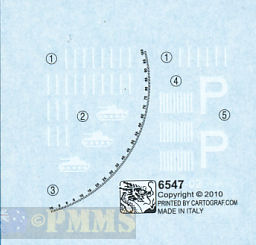
As with all kits of the FlaK 38/Flakvierling 38 replacing the plastic barrels with metal barrels will greatly improve the appearance.
Inclusion of the gun crew is a nice bonus if you want to put the gun in a diorama scene but as mentioned there is no transport trailer included.
Rating: Flakvierling 38: 8/10
Flakvierling 38 with crew: 8.5/10
A more detailed look at this kit compared to the others available will follow shortly as a full 5 way kit comparison of the AFV Club, Bronco, DML, Tamiya and Trumpeter Flakvierling kits.
Footnote: While this kit doesn’t include the Sd.Ah.52 trailer, the good news for modellers is it will fit with minor modifications to the Bronco Models Sd.Ah.52 trailer. Thankfully this will be released shortly by Bronco as a separate kit #CB-35079 so you don’t have to buy their full Flakvierling 38 kit just to get the trailer.
The DML triangular base has the actual base section the same length as both the AFV Club and Bronco kit bases but the trailing edge of the rear DML legs are about 1mm further forward than on the other kits. This along with the attachment hooks being way undersized means the overall base is about 2mm too short to fit the Bronco trailer as it comes.
To get the DML base to fit the Bronco trailer hitches you have to replace the base hooks with larger items made from plastic card or similar, this means the hooks will be slightly over scale but you will be able to fit the DML and Bronco trailer together for the Flakvierling in travel mode should you want this configuration.

Click on thumbnails for larger view




Detail Images



Click Browsers BACK button to return to page
 2cm
FlaK38
2cm
FlaK38Muzzle Reference images
| TM-E9-228 2cm Flakvierling 38 Four barrelled mount Easy 1 Productions  |
2 cm Flakvierling 38 Nuts & Bolts Vol.27  |
Flakpanzer IV Wirbelwind (Sd.Kdz. 161/4), Ostwind & Kugelblitz Nuts & Bolts Vol.25  |
| Flakpanzerkampfwagen IV and other Flakpanzer projects from 1942 to 1945 Panzer Tracks No.12-1  |
German
20mm FlaK in WWII 1395-1945 Schiffer Military History ISBN: 0-88740-758-7 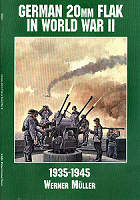 |
Sd.Kfz.7 in detail Special Museum Line No.36 Wings & Wheels Publications ISBN 80-86416-60-7  |
| Halbketten Zugkraftwagen 8t Sd.Kfz.7/1/2 AFV Super Detail Photo Vol.9 Published by Model Art Co.Ltd. 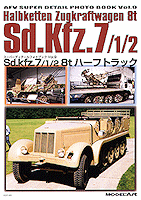 |
Flak
at War Trojca Publications Waldemar Trojca, Karlheinz Münch ISBN: 83-60041-15-6 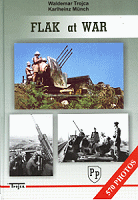 |
German Anti-Aircraft Combat Vehicles Revised Edition Ground Power Special Feb '08  |
 and
and  for
the review kits.
for
the review kits. 
